Akshat Shrivastava
CoDi: Conversational Distillation for Grounded Question Answering
Aug 20, 2024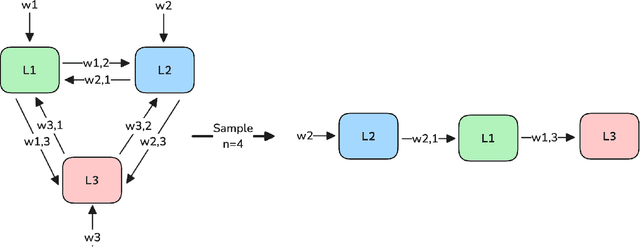
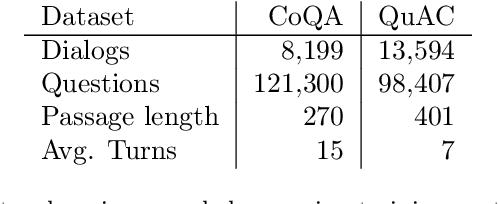
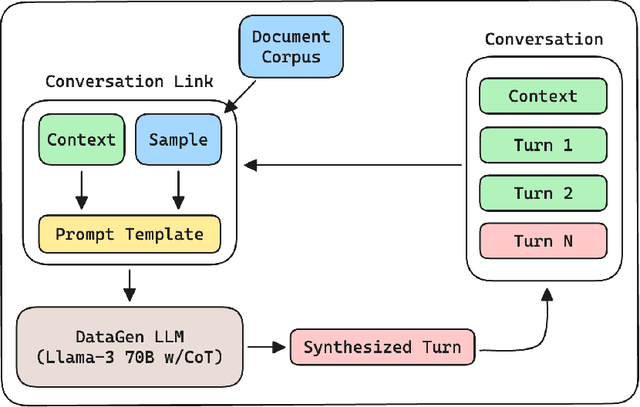
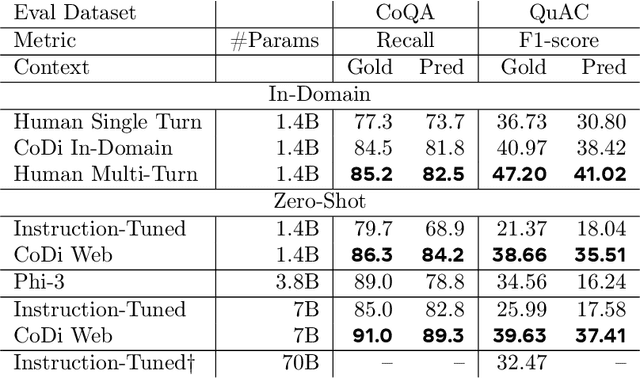
Abstract:Distilling conversational skills into Small Language Models (SLMs) with approximately 1 billion parameters presents significant challenges. Firstly, SLMs have limited capacity in their model parameters to learn extensive knowledge compared to larger models. Secondly, high-quality conversational datasets are often scarce, small, and domain-specific. Addressing these challenges, we introduce a novel data distillation framework named CoDi (short for Conversational Distillation, pronounced "Cody"), allowing us to synthesize large-scale, assistant-style datasets in a steerable and diverse manner. Specifically, while our framework is task agnostic at its core, we explore and evaluate the potential of CoDi on the task of conversational grounded reasoning for question answering. This is a typical on-device scenario for specialist SLMs, allowing for open-domain model responses, without requiring the model to "memorize" world knowledge in its limited weights. Our evaluations show that SLMs trained with CoDi-synthesized data achieve performance comparable to models trained on human-annotated data in standard metrics. Additionally, when using our framework to generate larger datasets from web data, our models surpass larger, instruction-tuned models in zero-shot conversational grounded reasoning tasks.
MoMa: Efficient Early-Fusion Pre-training with Mixture of Modality-Aware Experts
Jul 31, 2024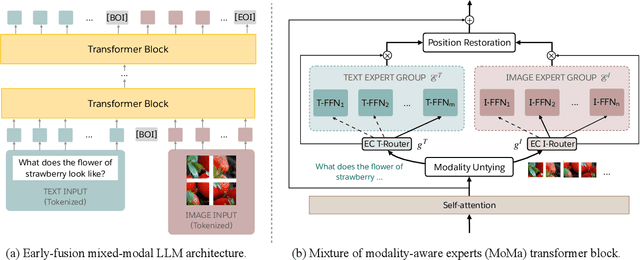

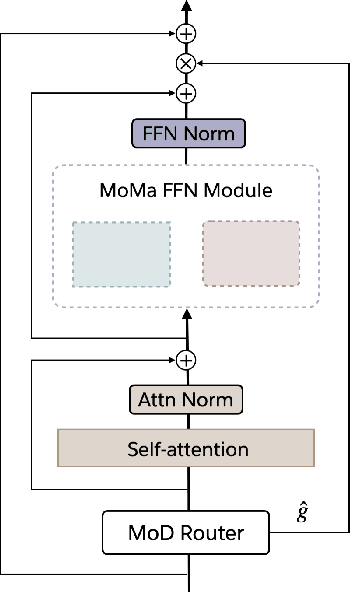
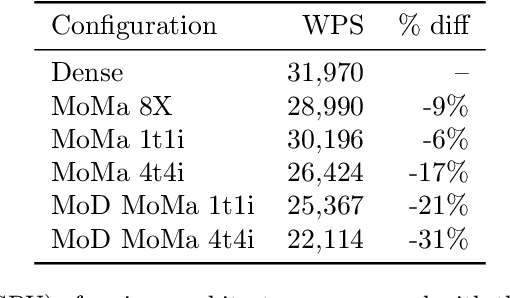
Abstract:We introduce MoMa, a novel modality-aware mixture-of-experts (MoE) architecture designed for pre-training mixed-modal, early-fusion language models. MoMa processes images and text in arbitrary sequences by dividing expert modules into modality-specific groups. These groups exclusively process designated tokens while employing learned routing within each group to maintain semantically informed adaptivity. Our empirical results reveal substantial pre-training efficiency gains through this modality-specific parameter allocation. Under a 1-trillion-token training budget, the MoMa 1.4B model, featuring 4 text experts and 4 image experts, achieves impressive FLOPs savings: 3.7x overall, with 2.6x for text and 5.2x for image processing compared to a compute-equivalent dense baseline, measured by pre-training loss. This outperforms the standard expert-choice MoE with 8 mixed-modal experts, which achieves 3x overall FLOPs savings (3x for text, 2.8x for image). Combining MoMa with mixture-of-depths (MoD) further improves pre-training FLOPs savings to 4.2x overall (text: 3.4x, image: 5.3x), although this combination hurts performance in causal inference due to increased sensitivity to router accuracy. These results demonstrate MoMa's potential to significantly advance the efficiency of mixed-modal, early-fusion language model pre-training, paving the way for more resource-efficient and capable multimodal AI systems.
PRoDeliberation: Parallel Robust Deliberation for End-to-End Spoken Language Understanding
Jun 12, 2024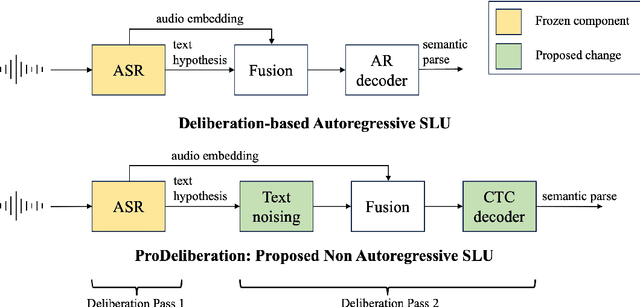

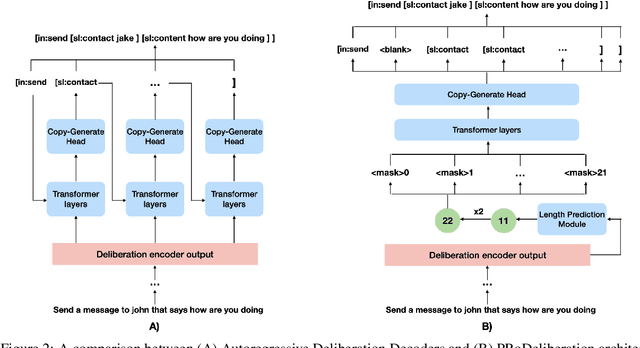
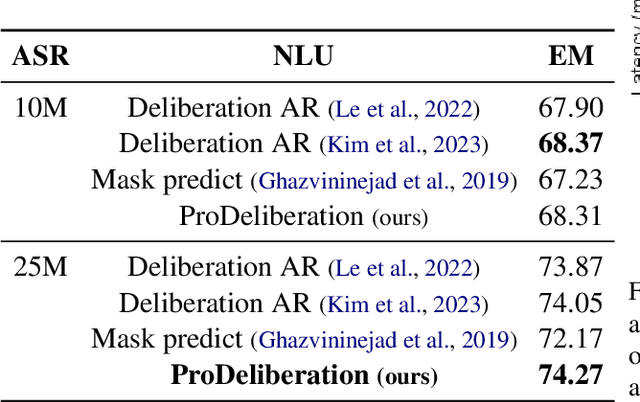
Abstract:Spoken Language Understanding (SLU) is a critical component of voice assistants; it consists of converting speech to semantic parses for task execution. Previous works have explored end-to-end models to improve the quality and robustness of SLU models with Deliberation, however these models have remained autoregressive, resulting in higher latencies. In this work we introduce PRoDeliberation, a novel method leveraging a Connectionist Temporal Classification-based decoding strategy as well as a denoising objective to train robust non-autoregressive deliberation models. We show that PRoDeliberation achieves the latency reduction of parallel decoding (2-10x improvement over autoregressive models) while retaining the ability to correct Automatic Speech Recognition (ASR) mistranscriptions of autoregressive deliberation systems. We further show that the design of the denoising training allows PRoDeliberation to overcome the limitations of small ASR devices, and we provide analysis on the necessity of each component of the system.
PrE-Text: Training Language Models on Private Federated Data in the Age of LLMs
Jun 05, 2024Abstract:On-device training is currently the most common approach for training machine learning (ML) models on private, distributed user data. Despite this, on-device training has several drawbacks: (1) most user devices are too small to train large models on-device, (2) on-device training is communication- and computation-intensive, and (3) on-device training can be difficult to debug and deploy. To address these problems, we propose Private Evolution-Text (PrE-Text), a method for generating differentially private (DP) synthetic textual data. First, we show that across multiple datasets, training small models (models that fit on user devices) with PrE-Text synthetic data outperforms small models trained on-device under practical privacy regimes ($\epsilon=1.29$, $\epsilon=7.58$). We achieve these results while using 9$\times$ fewer rounds, 6$\times$ less client computation per round, and 100$\times$ less communication per round. Second, finetuning large models on PrE-Text's DP synthetic data improves large language model (LLM) performance on private data across the same range of privacy budgets. Altogether, these results suggest that training on DP synthetic data can be a better option than training a model on-device on private distributed data. Code is available at https://github.com/houcharlie/PrE-Text.
LayerSkip: Enabling Early Exit Inference and Self-Speculative Decoding
Apr 29, 2024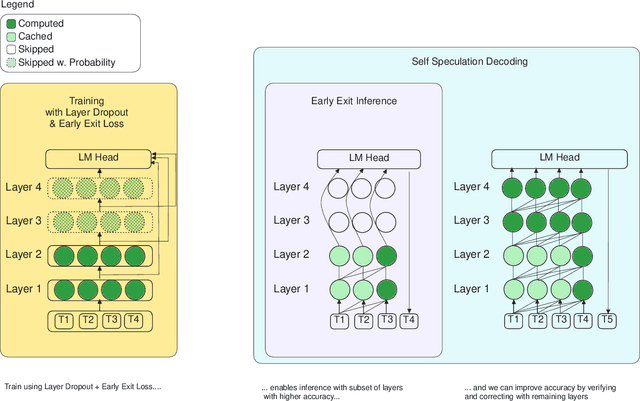
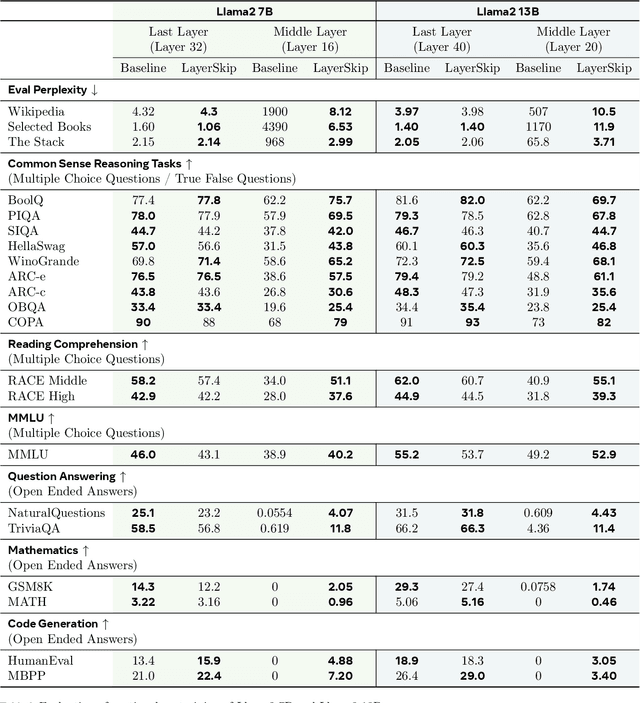

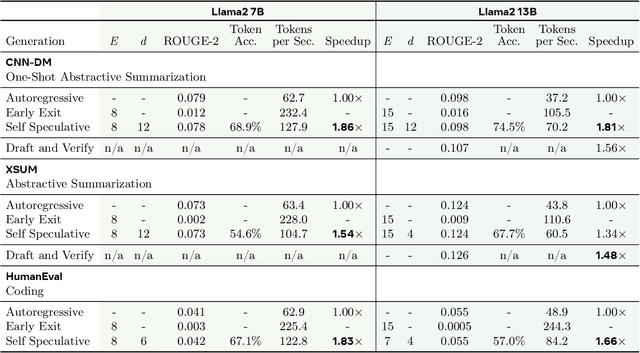
Abstract:We present LayerSkip, an end-to-end solution to speed-up inference of large language models (LLMs). First, during training we apply layer dropout, with low dropout rates for earlier layers and higher dropout rates for later layers, and an early exit loss where all transformer layers share the same exit. Second, during inference, we show that this training recipe increases the accuracy of early exit at earlier layers, without adding any auxiliary layers or modules to the model. Third, we present a novel self-speculative decoding solution where we exit at early layers and verify and correct with remaining layers of the model. Our proposed self-speculative decoding approach has less memory footprint than other speculative decoding approaches and benefits from shared compute and activations of the draft and verification stages. We run experiments on different Llama model sizes on different types of training: pretraining from scratch, continual pretraining, finetuning on specific data domain, and finetuning on specific task. We implement our inference solution and show speedups of up to 2.16x on summarization for CNN/DM documents, 1.82x on coding, and 2.0x on TOPv2 semantic parsing task.
Small But Funny: A Feedback-Driven Approach to Humor Distillation
Feb 28, 2024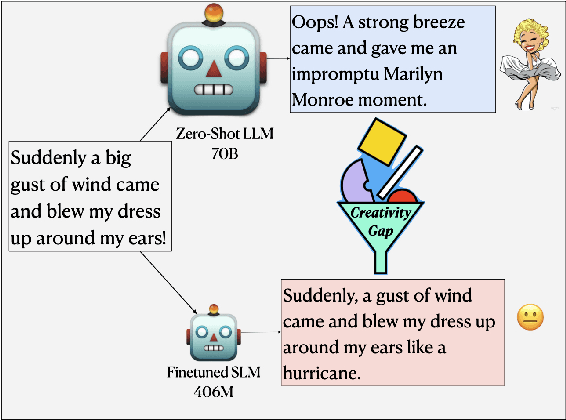



Abstract:The emergence of Large Language Models (LLMs) has brought to light promising language generation capabilities, particularly in performing tasks like complex reasoning and creative writing. Consequently, distillation through imitation of teacher responses has emerged as a popular technique to transfer knowledge from LLMs to more accessible, Small Language Models (SLMs). While this works well for simpler tasks, there is a substantial performance gap on tasks requiring intricate language comprehension and creativity, such as humor generation. We hypothesize that this gap may stem from the fact that creative tasks might be hard to learn by imitation alone and explore whether an approach, involving supplementary guidance from the teacher, could yield higher performance. To address this, we study the effect of assigning a dual role to the LLM - as a "teacher" generating data, as well as a "critic" evaluating the student's performance. Our experiments on humor generation reveal that the incorporation of feedback significantly narrows the performance gap between SLMs and their larger counterparts compared to merely relying on imitation. As a result, our research highlights the potential of using feedback as an additional dimension to data when transferring complex language abilities via distillation.
Augmenting text for spoken language understanding with Large Language Models
Sep 17, 2023



Abstract:Spoken semantic parsing (SSP) involves generating machine-comprehensible parses from input speech. Training robust models for existing application domains represented in training data or extending to new domains requires corresponding triplets of speech-transcript-semantic parse data, which is expensive to obtain. In this paper, we address this challenge by examining methods that can use transcript-semantic parse data (unpaired text) without corresponding speech. First, when unpaired text is drawn from existing textual corpora, Joint Audio Text (JAT) and Text-to-Speech (TTS) are compared as ways to generate speech representations for unpaired text. Experiments on the STOP dataset show that unpaired text from existing and new domains improves performance by 2% and 30% in absolute Exact Match (EM) respectively. Second, we consider the setting when unpaired text is not available in existing textual corpora. We propose to prompt Large Language Models (LLMs) to generate unpaired text for existing and new domains. Experiments show that examples and words that co-occur with intents can be used to generate unpaired text with Llama 2.0. Using the generated text with JAT and TTS for spoken semantic parsing improves EM on STOP by 1.4% and 2.6% absolute for existing and new domains respectively.
Modality Confidence Aware Training for Robust End-to-End Spoken Language Understanding
Jul 22, 2023Abstract:End-to-end (E2E) spoken language understanding (SLU) systems that generate a semantic parse from speech have become more promising recently. This approach uses a single model that utilizes audio and text representations from pre-trained speech recognition models (ASR), and outperforms traditional pipeline SLU systems in on-device streaming scenarios. However, E2E SLU systems still show weakness when text representation quality is low due to ASR transcription errors. To overcome this issue, we propose a novel E2E SLU system that enhances robustness to ASR errors by fusing audio and text representations based on the estimated modality confidence of ASR hypotheses. We introduce two novel techniques: 1) an effective method to encode the quality of ASR hypotheses and 2) an effective approach to integrate them into E2E SLU models. We show accuracy improvements on STOP dataset and share the analysis to demonstrate the effectiveness of our approach.
TreePiece: Faster Semantic Parsing via Tree Tokenization
Mar 30, 2023



Abstract:Autoregressive (AR) encoder-decoder neural networks have proved successful in many NLP problems, including Semantic Parsing -- a task that translates natural language to machine-readable parse trees. However, the sequential prediction process of AR models can be slow. To accelerate AR for semantic parsing, we introduce a new technique called TreePiece that tokenizes a parse tree into subtrees and generates one subtree per decoding step. On TopV2 benchmark, TreePiece shows 4.6 times faster decoding speed than standard AR, and comparable speed but significantly higher accuracy compared to Non-Autoregressive (NAR).
Privately Customizing Prefinetuning to Better Match User Data in Federated Learning
Feb 23, 2023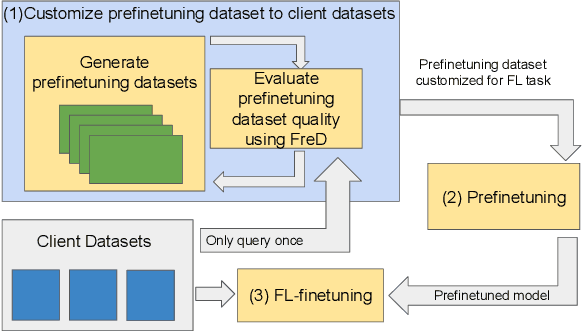



Abstract:In Federated Learning (FL), accessing private client data incurs communication and privacy costs. As a result, FL deployments commonly prefinetune pretrained foundation models on a (large, possibly public) dataset that is held by the central server; they then FL-finetune the model on a private, federated dataset held by clients. Evaluating prefinetuning dataset quality reliably and privately is therefore of high importance. To this end, we propose FreD (Federated Private Fr\'echet Distance) -- a privately computed distance between a prefinetuning dataset and federated datasets. Intuitively, it privately computes and compares a Fr\'echet distance between embeddings generated by a large language model on both the central (public) dataset and the federated private client data. To make this computation privacy-preserving, we use distributed, differentially-private mean and covariance estimators. We show empirically that FreD accurately predicts the best prefinetuning dataset at minimal privacy cost. Altogether, using FreD we demonstrate a proof-of-concept for a new approach in private FL training: (1) customize a prefinetuning dataset to better match user data (2) prefinetune (3) perform FL-finetuning.
 Add to Chrome
Add to Chrome Add to Firefox
Add to Firefox Add to Edge
Add to Edge